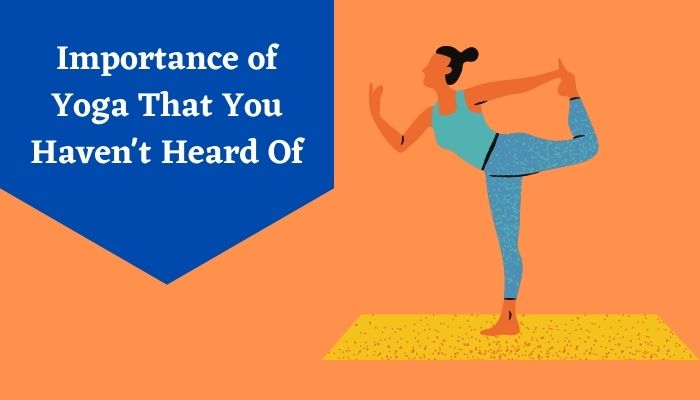Yoga is a mind-body practise that originated in India thousands of years ago, which aims to enhance an individual's well-being. It has gained popularity in the West as a fitness trend for its ability to improve flexibility, strength, and mental focus.
Research also shows that it can be beneficial for chronic disease prevention by lowering the risk factors associated with many common diseases.

Yoga is an effective complementary health approach for cancer survivors since it can address the effects of treatment on physical and mental well-being, as well as managing side effects like pain, fatigue, and stress. Because yoga has been shown to reduce pain, nausea/vomiting, fatigue, anxiety/depression symptoms, and to increase positive moods, it plays a role in cancer recovery.
Yoga can also be used as a form of mind-body medicine for women diagnosed with breast cancer. It has been shown to have great effects when treating emotional distress related to illness, treatment, coping, and social relationships.
Is yoga different from exercises?
Yes, yoga is different from exercise. While exercises are designed to improve physical fitness, strength, and appearance, yoga is designed to improve overall health and well-being by integrating the body, mind, and spirit. Yoga also uses specific poses, or asanas, that are meant to open up energy channels in the body and promote relaxation.How is yoga important in our lives?
There are plenty of reasons, but many people only focus on the physical benefits. Yoga has a lot to offer spiritually and mentally as well.
1. Improved moods:
Regular yoga practice can help improve your moods by releasing endorphins. This means you'll feel better overall and be less likely to experience negative emotions like anxiety and depression.
2. Increased flexibility:
As you continue practising yoga, you'll find that your flexibility improves. This is because yoga poses to stretch out your muscles and joints, which can help to reduce pain and stiffness.
3. Treats Insomnia:
As you practice yoga, your mind will be better able to focus on the present. This means you'll have less trouble falling asleep and that you'll experience deeper levels of sleep.
4. Improved breathing:
Many people don't realize how important good breathing is for overall health. Yoga can help improve your breathing habits, which in turn will improve your overall health.
5. Increased strength:
As you hold yoga poses longer, you'll gradually build muscle strength. This is a good way to increase your overall strength without putting too much pressure on the body.
How is Yoga Beneficial for students?
Yoga is beneficial for students as it has been known to help improve bodily coordination, concentration, and memory. In addition, studies have also shown that yoga can help to reduce stress which can be a huge problem in today's classroom environment.There are several poses within the Yoga sun salutation sequence that will bring strength and stability to the body. The Warrior I (Virabhadrasana I) and the Extended Triangle Pose (Utthita Trikonasana) are two examples of poses that students can do to feel more alert and focused in class.
In addition, the Child's Pose (Balasana) is a great way for students to relax and ease their minds from the stresses of school.
Some unknown Benefits of Yoga
There are many benefits to practising yoga, some of which are well known. However, there are also a few benefits of yoga that you may not have heard of. Here are a few of the most overlooked benefits of yoga:
Yoga can help improve your balance
When you practice yoga, you learn how to control your breathing, making it slower and more controlled. This gives you an increased sense of balance, which can help your physical well-being in many ways too.
Yoga benefits the brain
Yoga provides a range of health benefits, but did you know that it can even improve mental health? Yoga has been shown to help relieve stress and anxiety and can even help you learn how to be more accepting of yourself.
Yoga increases flexibility and strength
Yoga is a great way to increase your muscle strength and endurance without having to use any weights or machines. It also makes your muscles and joints much more flexible, which has many health benefits too.
Yoga can help you lose weight
Although not all yoga poses are aimed at weight loss, the practice as a whole does have the ability to help you lose weight. This is because yoga helps to improve your overall metabolism and digestion, as well as helps you to become more aware of your body.
Yoga can help relieve pain
Studies have shown that yoga can be an effective way to relieve pain, both physical and mental. This is because yoga helps to improve blood circulation and reduce inflammation.
Yoga can help you sleep better
Many people who practise yoga find that they sleep better at night. This is because yoga helps to calm the mind and relax the body, allowing you to fall asleep more easily and stay asleep for longer.
Not all yoga is meditation, but it can help reduce stress
Although many people might think that all of the yoga revolves around meditation, this isn't actually the case. Many different types of yoga exist, and some focus on poses over-breathing and chanting. However, even some yoga poses can help to reduce stress, which is important for the mind and body.
Yoga has been shown to help with arthritis
Yoga helps to maintain flexibility in your joints, helping you avoid some of the pain that's associated with old age conditions such as osteoarthritis or rheumatoid arthritis.
Yoga can help improve your fertility
Although yoga is not always aimed at improving fertility, one of the side effects of regular yoga practice is that it has been shown to increase ovarian function and blood flow in women trying to conceive.
Yoga can help you quit smoking
Although many people don't think of yoga as a tool to help you stop smoking, studies have shown that practising yoga can actually help people quit smoking in just four days! This is because yoga helps to reduce nicotine withdrawal symptoms, such as anxiety and depression.

